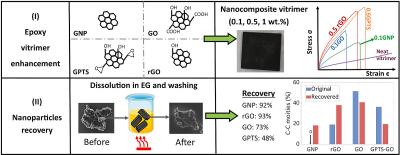Researchers from The University of Manchester and Australia's Monash University have studied the effect of graphene functionalization on a vitrimer matrix (chemically crosslinked network able to undergo covalent bonds exchange reaction under a trigger). The chosen matrix was an epoxy vitrimer which, under heat, can exchange ester bonds, to be reprocessed, healed or relax stress while remaining covalently crosslinked. Existing work on vitrimer shows the aforementioned properties, so the team chose to focus on more unexploited properties of vitrimer for nanocomposites: their dissolution in an appropriate solvent to break the covalent bond under mild condition.

In the paper, the team shows that adding 4 kinds of graphene or functionalized graphene allows to tune some properties of the vitrimer matrix. After characterization, the epoxy is dissolved in ethylene glycol at 180C for 2h, the nanoparticles are subsequently separated and washed. The recovered nanoparticles are then free of any traces of epoxy, and intense characterization shows that despite some functionalization or unfunctionalization of graphene (depending of the initial graphene type used), the nanoparticles keep their core structure and could potentially be re-used in another matrix.
Epoxy vitrimers present many advantages compared to traditional epoxy thermoset, such as stress relaxation and recycling capacity. This study explored the effect of graphitic nanoparticles on an epoxy vitrimer formulation and the potential to recover those from the crosslinked structure by mild dissolution.
Graphene nanoplatelets (GNP), graphene oxide (GO), reduced graphene oxide (rGO) and silane bearing epoxy functionalized graphene nanoplatelets (GPTS-GO) are added to the vitrimer at 0.1, 0.5 and 1 wt % loading.
Evolution in tensile properties and XRD reveal that nanoparticles bond with the vitrimer matrix when having functionality (GO, rGO and GPTS-GO). Overall, an improvement of tensile mechanical properties is reported while remaining chemically crosslinked and achieving complete relaxation.
The vitrimer properties are then exploited to recover nanoparticles via a simple dissolution/washing method. Chemical investigation (XPS, RAMAN, and XRD) of recovered particles shows no traces of polymer.
Nonetheless, few chemical changes are observed: nanoparticles with low functionality (GNP and rGO) received additional hydroxyl functions after recycling. Reversibly, highly functionalized particles (GO and GPTS-GO) undergo cleaving of functional units during the extraction process.

